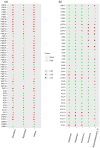Biosyntheses characterization of alkaloids and flavonoids in Sophora flavescens by combining metabolome and transcriptome
- PMID: 33795823
- PMCID: PMC8016917
- DOI: 10.1038/s41598-021-86970-0
Biosyntheses characterization of alkaloids and flavonoids in Sophora flavescens by combining metabolome and transcriptome
Abstract
Sophora flavescens are widely used for their pharmacological effects. As its main pharmacological components, alkaloids and flavonoids are distributed in the root tissues wherein molecular mechanisms remain elusive. In this study, metabolite profiles are analyzed using metabolomes to obtain biomarkers detected in different root tissues. These biomarkers include alkaloids, phenylpropanoids, and flavonoids. The high-performance liquid chromatography analysis results indicate the differences in principal component contents. Oxymatrine, sophoridine, and matrine contents are the highest in the phloem, whereas trifolirhizin, maackiain, and kushenol I contents are the highest in the xylem. The transcript expression profiles also show tissue specificity in the roots. A total of 52 and 39 transcripts involved in alkaloid and flavonoid syntheses are found, respectively. Among them, the expression levels of LYSA1, LYSA2, AO2, AO6, PMT1, PMT17, PMT34, and PMT35 transcripts are highly and positively correlated with alkaloids contents. The expression levels of 4CL1, 4CL3, 4CL12, CHI5, CHI7, and CHI9 transcripts are markedly and positively correlated with flavonoids contents. Moreover, the quantitative profiles of alkaloids and flavonoids are provided, and the pivotal genes regulating their distribution in S. flavescens are determined. These results contribute to the existing data for the genetic improvement and target breeding of S. flavescens.
Conflict of interest statement
The authors declare no competing interests.
Figures






Similar articles
-
[Analysis and evaluation of alkaloids and flavonoids in flower of Sophora flavescens from Shanxi province].Zhongguo Zhong Yao Za Zhi. 2016 Dec;41(24):4621-4627. doi: 10.4268/cjcmm20162422. Zhongguo Zhong Yao Za Zhi. 2016. PMID: 28936847 Chinese.
-
Simultaneous determination of matrine, sophoridine and oxymatrine in Sophora flavescens Ait. by high performance liquid chromatography.Biomed Chromatogr. 2004 Apr;18(3):178-82. doi: 10.1002/bmc.308. Biomed Chromatogr. 2004. PMID: 15103704
-
[Non-alkaloid components from Sophora flavescens].Zhongguo Zhong Yao Za Zhi. 2013 Oct;38(20):3520-4. Zhongguo Zhong Yao Za Zhi. 2013. PMID: 24490565 Chinese.
-
Structural Modifications of Matrine-Type Alkaloids.Mini Rev Med Chem. 2018;18(9):730-744. doi: 10.2174/1389557516666161104150334. Mini Rev Med Chem. 2018. PMID: 27823557 Review.
-
Matrine-Family Alkaloids: Versatile Precursors for Bioactive Modifications.Med Chem. 2020;16(4):431-453. doi: 10.2174/1573406415666190507121744. Med Chem. 2020. PMID: 31378199 Review.
Cited by
-
Application of High-Throughput Sequencing on the Chinese Herbal Medicine for the Data-Mining of the Bioactive Compounds.Front Plant Sci. 2022 Jul 14;13:900035. doi: 10.3389/fpls.2022.900035. eCollection 2022. Front Plant Sci. 2022. PMID: 35909744 Free PMC article. Review.
-
Bacteroid Development, Transcriptome, and Symbiotic Nitrogen-Fixing Comparison of Bradyrhizobium arachidis in Nodules of Peanut (Arachis hypogaea) and Medicinal Legume Sophora flavescens.Microbiol Spectr. 2023 Feb 14;11(1):e0107922. doi: 10.1128/spectrum.01079-22. Epub 2023 Jan 19. Microbiol Spectr. 2023. PMID: 36656008 Free PMC article.
-
Combined Metabolomics and Transcriptomics Analysis of the Distribution of Flavonoids in the Fibrous Root and Taproot of Polygonatum kingianum Coll.et Hemsl.Genes (Basel). 2024 Jun 22;15(7):828. doi: 10.3390/genes15070828. Genes (Basel). 2024. PMID: 39062607 Free PMC article.
-
Estrogenic Prenylated Flavonoids in Sophora flavescens.Genes (Basel). 2024 Feb 4;15(2):204. doi: 10.3390/genes15020204. Genes (Basel). 2024. PMID: 38397194 Free PMC article.
-
Osteogenic Activities of Trifolirhizin as a Bioactive Compound for the Differentiation of Osteogenic Cells.Int J Mol Sci. 2023 Dec 4;24(23):17103. doi: 10.3390/ijms242317103. Int J Mol Sci. 2023. PMID: 38069425 Free PMC article.
References
-
- Zhao P, Zhang YJ, Yamamoto H, Yang CR. Recent advance on the chemistry, bioactivity and biosynthesis of prenylated flavonoids from Sophora flavecens. Nat. Prod. Res. Dev. 2004;16:172–178.
-
- Gao, X.M. Traditional Chinese medicine. Beijing; China. Trad. Chin. Med. Pub. 1283 (2007).
-
- Sun J, et al. Effect of matrine sodium chloride injection on a mouse model combining disease with syndrome of human coronavirus pneumonia with cold-dampness pestilence attack on the lung. Acta Pharm. Sin. 2020;55:366–373.
-
- Yang MW, et al. Clinical effecacy of matrine and sodium chloride injection in the treatment of 40 cases of COVID-19. Chin. J. Chin. Mater. Med. 2020;45:2221–2231. - PubMed
Publication types
MeSH terms
Substances
LinkOut - more resources
Full Text Sources
Other Literature Sources
Research Materials

